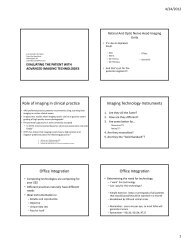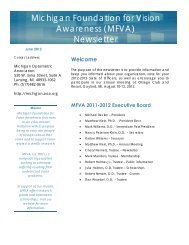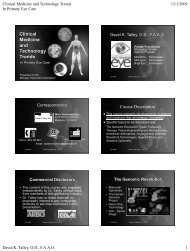New Year's Resolutions: - Michigan Optometric Association ...
New Year's Resolutions: - Michigan Optometric Association ...
New Year's Resolutions: - Michigan Optometric Association ...
Create successful ePaper yourself
Turn your PDF publications into a flip-book with our unique Google optimized e-Paper software.
MOA November Press Release<br />
Majority of Americans Lack<br />
Awareness of Diabetic<br />
Eye Disease<br />
The MOA utilized National Diabetes Awareness<br />
Month to urge Americans living with diabetes to<br />
schedule yearly comprehensive eye exams to help<br />
detect diabetic eye disease.<br />
Since diabetes is the leading cause of new cases<br />
of blindness in adults 20-74 years of age, early<br />
detection is critical. Each year, 12,000 – 24,000<br />
people lose their sight because diabetic eye disease<br />
rarely has early warning signs. Detection begins<br />
with having a dilated eye examination every<br />
year to check for signs of diabetic eye disease and<br />
following a course of action recommended by an<br />
optometrist.<br />
Results from the AOA’s 2011 American Eye-<br />
Q® consumer survey revealed that 55 percent of<br />
people are unaware that diabetic eye disease often<br />
has no visual signs or symptoms. Additionally, 44<br />
percent of Americans don’t know that a person<br />
with diabetes should have a comprehensive eye<br />
exam once a year.<br />
“When optometrists dilate a patient’s eyes during<br />
an eye exam, they have a clear view of the<br />
retina and can look for indications of diabetic eye<br />
disease, such as leaking blood vessels, swelling<br />
and deposits within the retina,” said Dr. Matthew<br />
Johnson an MOA trustee and practicing optometrist<br />
at the Battle Creek VA Medical Center. “Optometrists<br />
often serve as the first line of detection<br />
for diabetes, since the eye is the only place in<br />
the body that blood vessels can be seen in their<br />
natural condition without having to surgically cut<br />
through skin.”<br />
Without yearly comprehensive eye exams, conditions<br />
such as diabetic retinopathy can go unnoticed<br />
by patients until the disease has further pro-<br />
November/December, 2011<br />
www.themoa.org<br />
gressed towards blindness. Diabetic retinopathy is<br />
also linked to increased risk of kidney, heart and<br />
nerve disease, making its earlier detection even<br />
more important.<br />
“A patient with diabetes can help prevent or<br />
slow the development of diabetic retinopathy by<br />
taking prescribed medication as directed, sticking<br />
to a healthy diet, exercising regularly, controlling<br />
high blood pressure and abnormal blood cholesterol<br />
levels, and avoiding alcohol and smoking,”<br />
Dr. Johnson said. “Once the disease develops,<br />
the potential for significant vision loss can be<br />
dramatically reduced by more aggressive blood<br />
sugar, pressure and cholesterol control and timely<br />
referral for laser treatment, when appropriate. In<br />
addition, newer medications for retinopathy have<br />
recently been shown to be very effective for preserving,<br />
and sometimes improving vision. The key<br />
is to detect the problem early so that the chances<br />
of maintaining good eyesight are maximized.”<br />
Several factors influence whether someone with<br />
diabetes develops diabetic retinopathy. These<br />
include poor blood sugar, blood pressure, and<br />
blood lipid control, the length of time with diabetes,<br />
race and family history. However, the majority<br />
of people diagnosed with diabetes will have<br />
some degree of retinopathy within twenty years<br />
of diagnosis.<br />
“By the year 2020, the number of people suffering<br />
from diabetic eye disease is expected to<br />
nearly double,” Dr. Johnson said. “To that end,<br />
the fact that eye diseases like diabetic retinopathy<br />
often progress silently, without symptoms, must<br />
become common knowledge.”<br />
Image: graur codrin / FreeDigitalPhotos.net<br />
ABOUT MOA PUBLIC RELATIONS:<br />
The MOA issues a press release to <strong>Michigan</strong> media each month. The releases are based on national<br />
campaigns conducted by the AOA and their public relations firm, Hill & Knowlton, which are customized<br />
for <strong>Michigan</strong> and feature in-state MOA members as spokespeople. Visit the Media Center at www.<br />
themoa.org and watch MOA email communications for copies of the releases.<br />
If you are interested in becoming a media-trained spokesperson for the MOA, please contact MOA<br />
Communications Coordinator Bryan Dahl at bryan@themoa.org for more information.<br />
19
















